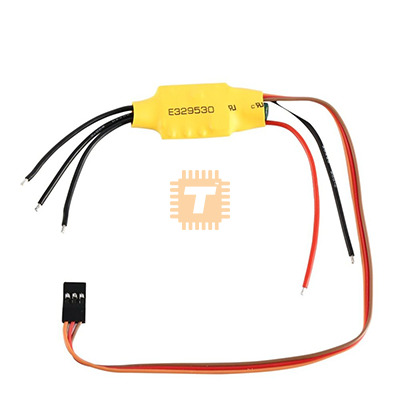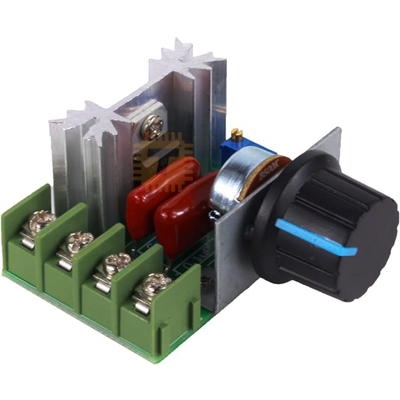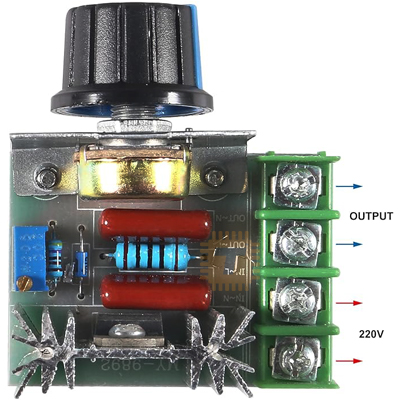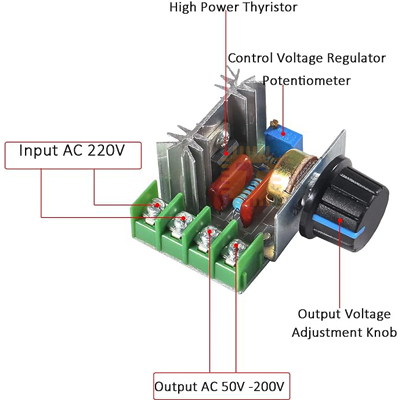| Name | PWM Motor Speed Controller 50-220VAC 25A 2000W SCR Voltage Regulator Adjustable |
| Code | MD0971 |
| Price | Rs.260.00 |
| In Stock | No |
| Package | MODULE |
This 2000 W PWM AC Motor Speed Control Module is a low-cost, fairly high-power AC voltage-regulation module (up to 2000 W, ~25 A) that can be used for dimming, speed-control, and thermal control of AC devices. It works by adjusting AC voltage (not frequency) via SCR phase control. It’s best suited for simple loads (fans, heaters, small motors) rather than large industrial motors. Proper wiring, heat management, and understanding of the load type are key to safe and effective use.
Features :
- This module allows you to adjust the AC output voltage to a load, thereby controlling things like motor speed, brightness of lighting, or heat output of resistive elements. For example: the module is described as suitable for “electric stove, water heater tune thermal, lighting dimmer, small motor speed, electric iron thermostat” in its listing.
- It is designed to be placed in series with the load (i.e., line in → module → load → neutral) and then a knob/potentiometer is used to vary the output voltage.
- Because it uses SCR / phase control, the voltage applied to the load can be reduced from the full mains RMS by delaying the conduction angle each AC cycle — thus achieving “soft” control of motor speed or heat.
- The module mentions a built-in “self-recovery fuse” feature: when the current is too large, the module will disconnect (“fuse” action) and then automatically recover after cooling. This offers some overload protection.
Specifications :
- Supply voltage (AC): ≈ 110 V to 220 V (some listings say 110 V-250 V).
- Adjustable output (AC) voltage: ≈ 50 V to 220 V (or up to 250 V depending on listing).
- Maximum output power rating: 2000 W.
- Maximum output current: 25 A.
- Environment temperature: approximately -20 °C to +40 °C listed.
- Typical module size: e.g., 48 mm × 60 mm × 28 mm (for one variant).
- Technology: Uses a high-power bi-directional SCR (Silicon Controlled Rectifier) for phase control / voltage regulation.
Applications :
- Controlling small AC motors (for example fans, blowers, etc) — adjusting speed (within limits).
- Dimming AC lighting (although note the load type matters).
- Adjusting heat in resistive devices (heaters, irons) by controlling applied voltage (thus heat output).
- Any application where you need adjustable AC output voltage (within the module’s specification).
Usage Tips :
- Ensure mains supply is off/disconnected.
- Connect the module in series with your load: mains live → module input live, module output live → load; neutral of mains goes to load neutral (unless the module supports both lines).
- Connect the potentiometer or knob (if provided) for adjusting output (most modules have a small blue trim-pot on board). Some also include mounting holes for a knob.
- Power on and gradually adjust the knob: the module will vary the voltage, thus reducing/increasing the speed or brightness or heat of your load.
- Monitor your load’s behaviour: if motor hums or stalls when voltage is too low, increase voltage until reliable operation.
- Ensure module does not overheat: if it becomes hot, consider mounting on a heatsink or providing airflow.
Note :
- Although rated “2000 W”, that rating is only valid if the load is compatible, the mains voltage is adequate, wiring is proper, and thermal conditions are good. For motor loads, inrush current may be large, so in practical use the continuous safe power may be less.
- For motors, speed control via reducing voltage only works well for certain types of motors (especially universal motors or small induction motors with low starting torque). If the motor is a large induction motor with fixed poles, reducing voltage will reduce torque significantly and may stall or over-heat the motor.
- The module uses phase-angle control (SCR) so some electrical noise / harmonic distortion may result; proper wiring, maybe filtering, and good grounding is wise.
- The environment temperature range is limited; ensure adequate ventilation and heat-sinking if loaded near 2000 W.
- The module appears to be a budget / generic module (makers like “Sipytoph”) so documentation may be minimal; mounting and safety precautions are important (ensure insulation, isolation, proper fuse/protection).
- Does not change frequency of AC supply; it only changes amplitude (voltage). For full speed control of many AC motors (especially synchronous or three-phase motors) you may need a variable frequency drive (VFD) instead.
- Wiring must respect mains safety: disconnect power before wiring, use proper gauge wiring for 25 A, ensure correct isolation from bare parts, consider a protective enclosure.
Sharing is caring, show love and share the product with your friends.
Featured
Other Products















